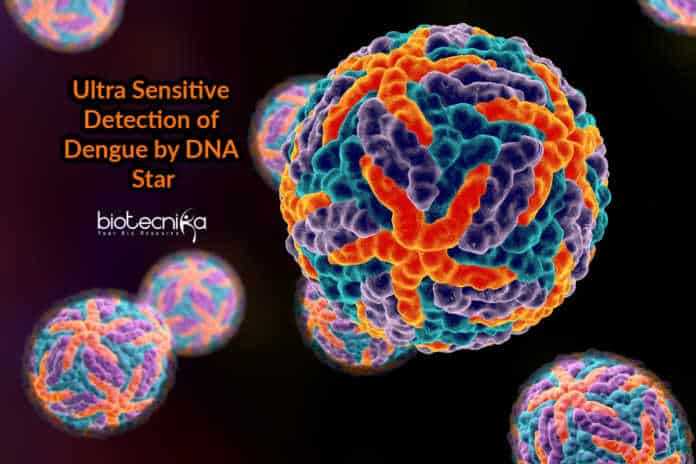Rensselaer Scientists develop a new technique for early detection of dengue virus
Scientists developed a trap for capturing dengue viruses in the bloodstream by folding fragments of DNA into the shape of a five-pointed star with the help of DNA structural nanotechnology.
The trap is non-toxic as well as is naturally cleared from the system. Once the trap captures the dengue virus, it lights up. This is the most sensitive tool discovered to date that diagnoses mosquito-borne diseases.
The work published in Nature Chemistry has the potential to expand to other viruses and modify the trap to kill the viruses it captures.
Xing Wang, the corresponding author of the study and assistant professor of chemistry at Rensselaer Polytechnic Institute commented that this is the most sensitive way of detecting dengue virus and it is 100 fold efficient compared to clinical tests.
The strong binding and specificity of the dengue virus to the trap enables the early detection of the virus on the very first day of infection.
This trap could be effective for different types of viruses because, in order to attack a cell, the virus must first attach to the cell membrane through the latch points and then discharge
the genetic material into the cell.In 2016 Robert Linhardt and Jonathan Dordick from Rensselaer constructed a synthetic polymer of sequence similar to sialic acid to trap the influenza virus. In the lung, influenza must bind to sialic acid to invade lung cells. The influenza virus must bind to sialic acid on the cell membrane to attack the cell. The polymer mimicked the cell membranes and captured the influenza viruses before it attacked lung cells.
The treatment was effective in mouse reducing the influenza A mortality from 100% to 25% in 14 days. However, Dordick and Linhardt, co-authors of the new study at Rensselaer Polytechnic Institute foresaw that the synthetic polymer might be toxic to the body and was likely to be rejected as a therapeutic.
The team overcame this challenge through Structural DNA nanotechnology, an established technique of folding DNA into desired geometric shapes and objects. Structural DNA nanotechnology offered the team a non-toxic biodegradable alternative for the synthetic polymer to trap the viruses.
The team designed a five-pointed star-shaped DNA trap that best matches with the latch points of the virus after mapping various DNA nanostructural shapes onto images of the virus.
Wang attached molecules to which the latches attach to, called aptamers on the vertices and tips of the DNA star to align with the distribution of latches on the virus. Instead of just one binding point, ten aptamers binding the virus to the star tighten the star’s hold to the virus.
Once the virus attaches to the DNA star, it starts emitting fluorescence facilitating the detection of dengue virus through a blood test.
Developing a biodegradable DNA star trap is just the first step. This can be later modified to a trap that kills the virus once it is bound to the trap. The team is planning to accomplish this by reconstructing the DNA star-shaped aptamers using the DNA origami platform. This is the first time scientists are using DNA nanostructure for such purpose. But the technology is vast and Linhardt expects to see it used in many other applications soon.
Rensselaer Polytechnic Institute, founded in 1824 is America’s first technological research university. Rensselaer comprises 32 research centers, more than 145 academic programs, five schools along with 7,900 students and over 100,000 living alumni. Rensselaer faculty and alumni include a Nobel Prize winner in Physics, five National Medal of Science winners, more than 145 National Academy members, six National Medal of Technology winners, and six members of the National Inventors Hall of Fame.
Author: Namitha Thampi






























